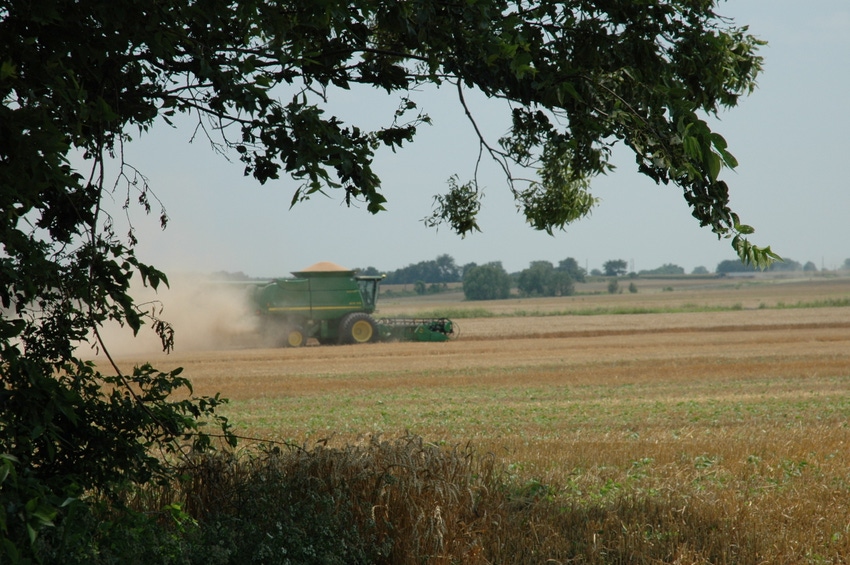
If Northeast Texas wheat farmers seem a bit sheepish about talking about harvest prospects, it’s because they feel genuine concern for their brethren in other parts of the state and the Southwest who will do well to cut a fraction of what combines are collecting from Northeast of Dallas to the Red River near the Oklahoma and Louisiana state lines.
Farmers in this fortunate corner of the state report yields averaging close to 60 bushels per acre with good test weights. Most got through the season with insignificant disease pressure and most sprayed fungicide on minimal acreage.
“A dry march may have hurt some fields with lighter soils,” says Jim Swart, Texas AgriLife Extension integrated pest management specialist out of Commerce. “But, overall, we have a good crop, and average will be close to 60 bushels per acre in many communities. Most varieties look good, and disease has been light to non-existent.”
Swart said Jackpot and Terrell 8558 may have benefited from a fungicide spray—Jackpot for leaf rust, 8558 for leaf rust and stripe rust. And those applications were made with an economical fungicide at $4 per acre or less.
“Other varieties, based on profitability studies, showed that they did not need a fungicide this year. Some farmers are using fungicides for insurance.”
Jack Norman, a Grayson county wheat and corn farmer, says he’s averaging 60 to 70 bushels per acre on much of his acreage. Fields with lighter soils are making 50 to 60 bushels, he says. “A dry March may have hurt that light land.”
Norman, who farms with his brother Alton and nephew Jay, says disease pressure “was not bad, not bad at all. We put fungicide on most of our acreage, but we didn’t spray the last 400 acres we planted, and we made 60 bushels per acre.”
He and Swart agree that late applications may have hurt yield this year with track damage to the plant.
“We didn’t see much loss from tracks where the fungicide was applied early, based on our yield monitors,” Norman says.
“The earlier farmers spray the less likely they’ll have track damage,” Swart says. “Late spring applications may cause some yield loss. Yield trials show we get less yield reduction when we apply fungicides early,” he says. “We will do a test next year to check yields for track losses.”
Norman says he applied tebuconazole on 95 percent of his acreage. “I think it helped test weight,” he says.
Swart and Norman say ryegrass escapes have caused problems in some fields. “We may have some herbicide resistance beginning to show up,” Swart says.
“It’s worse on fields we can’t rotate,” Norman adds.
Ben Scholz, who farms near McKinney, Texas, says his wheat is making “better than expected—50 to 60 bushels per acre with a good test weight. I’m just getting through with wheat harvest.”
Jay Norman, Wolfe City, Texas, says he’s pleased with the wheat crop. “It’s better than I expected, and I thought it would be pretty good. We had no disease pressure even in fields where we used no fungicide.”
He says test weight has been good. “We had rain in April that helped fill the grain out. Now, we need one more rain to make a corn crop. But it’s good to get a good wheat crop and a good price for it.”
Ronnie Lumpkins, who farms with his son, Brad, and daughter, Lana, near Leonard, Texas, says he lost a little wheat in just about every field to hail but still expects to average 60 bushels per acre. Brad says some fields will push 80 bushels per acre.
But that March dry spell hurt wheat on lighter soils.
“I have never seen it that dry in March before,” Lumpkins says. He says the crop was made on ample fall moisture around planting time and then April and May rainfall.
“Shallow soils will make less,” he says. “We usually don’t notice that because we usually get moisture in March.”
He planted varieties that are resistant to both leaf rust and stripe rust and did not use a fungicide this year. “I didn’t want to track it up,” he says. “It looked clean.”
Lana says one of the worst harvest problems was having enough trucks available to move the grain out of the fields. “I said last winter that I hoped our biggest challenge was getting enough trucks,” she says.
Farmers in the area say they haven’t had a lot of rainfall this year, but they got timely rain in April and May that filled out the grain. By late May and early June, skies had cleared leaving open weather for harvest.
About the Author(s)
You May Also Like






